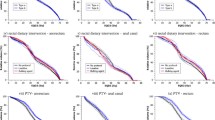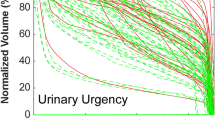Background:
The estimation of the parameters that describe the dose-response relations of anal sphincter regarding the clinical endpoints of fecal leakage and blood or phlegm in stools is important in the optimization of prostate cancer radiotherapy. Also, the validity of the relative seriality model for this clinical case needs to be examined by associating the clinical follow-up results with the predicted complication rates.
Patients and Methods:
In this study, 65 patients who received radiation therapy for clinically localized prostate adenocarcinoma are analyzed. The clinical treatment outcome and the three-dimensional dose distribution delivered to anal sphincter were available for each patient. A questionnaire was used for assessing the clinical bowel and urinary symptoms. A maximum likelihood fitting was performed to calculate the best estimates of the parameters used by the relative seriality model. The clinical utilization of the calculated parameters in predicting anal sphincter complication probabilities was illustrated by applying the best estimate of the parameters to a subset of the patient population.
Results:
The estimated values of the parameters for the two clinical endpoints are D 50 = 70.2 Gy, γ = 1.22, s = 0.35 for fecal leakage and D 50 = 74.0 Gy, γ = 0.75, s ≈ 0 for blood or phlegm in stools. The standard deviations of the parameters were also calculated together with the confidence intervals of the dose-response curves. The analysis proved that the treatment outcome pattern of the patient material can suitably be reproduced by the relative seriality model (probability of finding a worse fit = 60.2%, the area under the receiver operating characteristic curve = 0.72 and 0.69 and χ2-test = 0.97 and 0.86, respectively).
Conclusion:
Fecal leakage is characterized by a medium relative seriality whereas blood or phlegm in stools was found to have strong volume dependence (low relative seriality). Diminishing the biologically effective uniform dose to anal sphincter < 40–45 Gy may significantly reduce the risk of fecal leakage or blood or phlegm in stools for patients irradiated for prostate cancer.
Hintergrund:
Um die Strahlenbehandlung des Prostatakarzinoms optimieren zu können, ist ein Modell der Dosis-Wirkungs-Beziehung für die Analsphinkterfunktion notwendig, dessen Parameter verlässlich geschätzt werden können. Es sollte die klinischen Endpunkte Stuhlinkontinenz und Blut oder Schleim im Stuhl beschreiben. Zusätzlich sollte die Gültigkeit des Relative-Seriality-Modells überprüft werden, indem die Befunde des klinischen Follow-up mit den prognostizierten Komplikationsraten verglichen werden.
Patienten und Methodik:
Diese Studie umfasst 65 Patienten, die wegen eines klinisch manifesten lokalisierten Adenokarzinoms der Prostata eine Strahlenbehandlung erhalten hatten. Das klinische Ergebnis und die Dosisverteilung im Analsphinkter waren für jeden Patienten verfügbar. Klinische Symptome des Darms und der Harnwege wurden mittels eines Fragebogens erfasst. Die Parameter des Relative-Seriality-Modells wurden mit Hilfe der Maximum-Likelihood-Methode bestimmt. Bei einer Untergruppe der Patienten wurden die besten Schätzwerte der Parameter angewendet. Der klinische Nutzen für die Prognose von Komplikationen des Analsphinkters konnte dargestellt werden.
Ergebnisse:
Die Schätzwerte der Parameter der zwei klinischen Endpunkte sind D 50 = 70,2 Gy, γ = 1,22, s = 0,35 für Stuhlinkontinenz und D 50 = 74,0 Gy, γ = 0,75, s ≈ 0 für Blut oder Schleim im Stuhl. Die Standardabweichungen der Parameter wurden ebenso berechnet wie die Konfidenzintervalle. Die Analyse (untersucht wurden: Probability of Finding worse Fit = 60,2%, die Fläche unter ROC-Kurven 0,72 bzw. 0,69 und χ2 = 0,97 und 0,86) beweist, dass das Behandlungsergebnis bei den untersuchten Patienten mit Hilfe des Relative-Seriality-Modells gut wiedergegeben wird.
Schlussfolgerungen:
Die Stuhlinkontinenz zeigt eine mittlere Relative Seriality, während für Blut oder Schleim im Stuhl eine starke Volumenabhängigkeit gefunden wurde (geringe Relative Seriality). Eine Reduktion der biologisch effektiven, uniformen Dosis des Analsphinkters unter 40-45 Gy könnte die Risiken der Stuhlinkontinenz und von Blut oder Schleim im Stuhl für Prostatakarzinom-Patienten signifikant senken.
Similar content being viewed by others
Author information
Authors and Affiliations
Corresponding author
Rights and permissions
About this article
Cite this article
Mavroidis, P., al-Abany, M., Helgason, Á.R. et al. Dose-Response Relations for Anal Sphincter Regarding Fecal Leakage and Blood or Phlegm in Stools after Radiotherapy for Prostate Cancer. Strahlenther Onkol 181, 293–306 (2005). https://doi.org/10.1007/s00066-005-1313-y
Received:
Accepted:
Issue Date:
DOI: https://doi.org/10.1007/s00066-005-1313-y
Key Words:
- Radiobiological parameters
- Prostate cancer
- Fecal leakage
- Blood or phlegm in stools
- NTCP
- Relative seriality




